Social media apps have redefined how we connect and build networks, becoming a prominent part of our daily lives. As of 2021, 4.48 billion people worldwide are active social media users, accounting for more than half the world’s population. The increasing demand has led to an emerging, prosperous market for social networking apps.
With the social media app market booming with ample potential opportunities, there is no better time than now to ignite your inner Zuckerberg, Krieger (Instagram’s co-founder), or Dorsey (Twitter’s co-founder). And turn your unique idea into the next big social media app by following the below-mentioned steps.
This blog explains the complete process of building a social media app from scratch, with each phase explained in detail. In addition, it also talks about the cost breakdown of the app. Typically, the cost of a social media app can range from $45,000- $75,000, depending on many different factors.
5 essential steps to build a successful social media app
Step 1: Conduct comprehensive research
Bringing your social media app idea to life requires comprehensive market and competition research, which makes up the business analysis phase.
Market research
The number of social media users globally has almost doubled since 2016 and the significant rise can be seen in the graph below. Such increasing demand makes the social media app market one of the most favorable ones to enter.
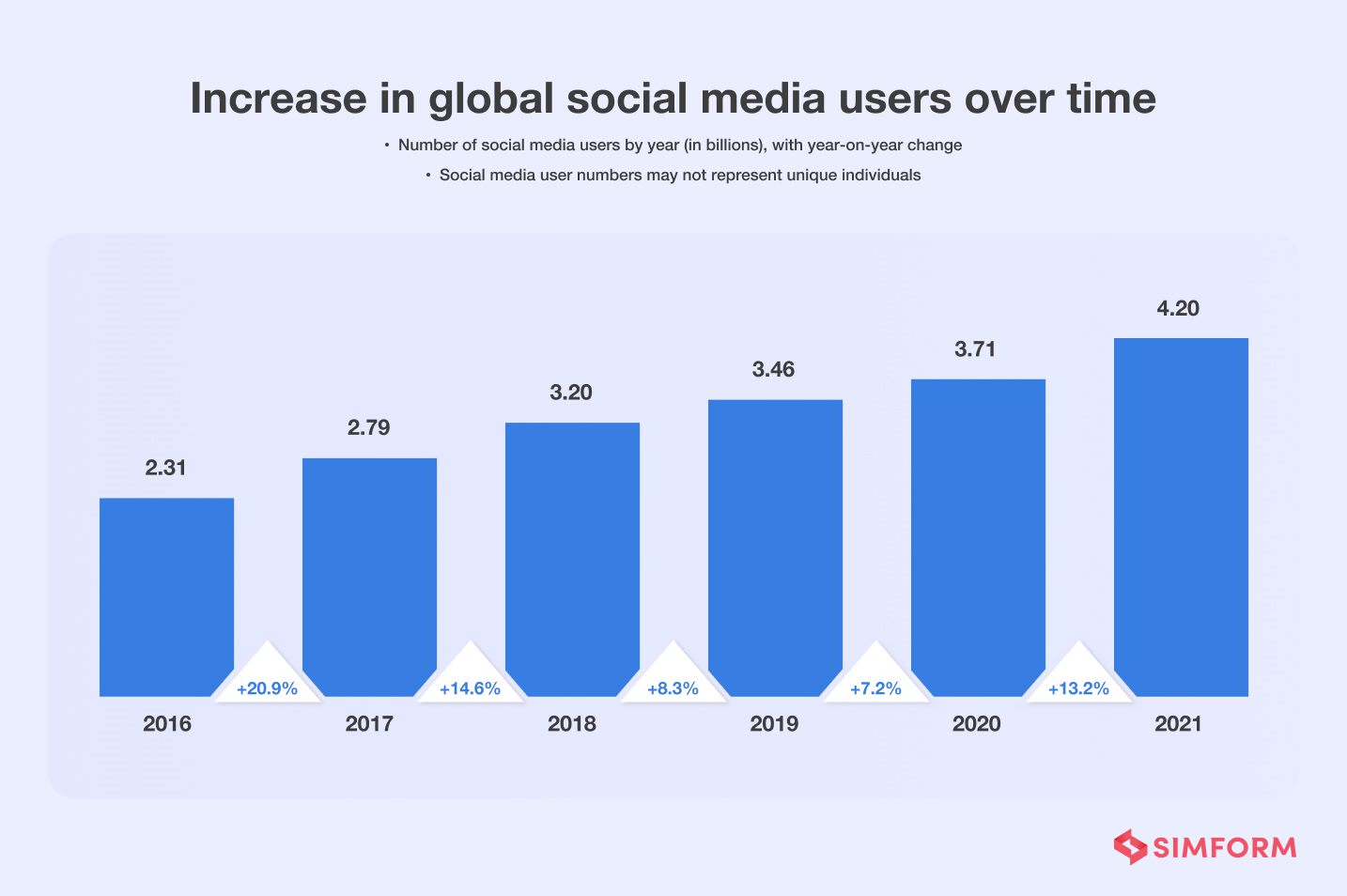
Market research will further help understand the unique needs of users and help define your social media app’s exact purpose. It will also help you know the target audience better, understand the niche you’re going to enter and its inherent features. According to the existing trends in the social media app market, your app will fall into either of these categories shown below along with some examples.
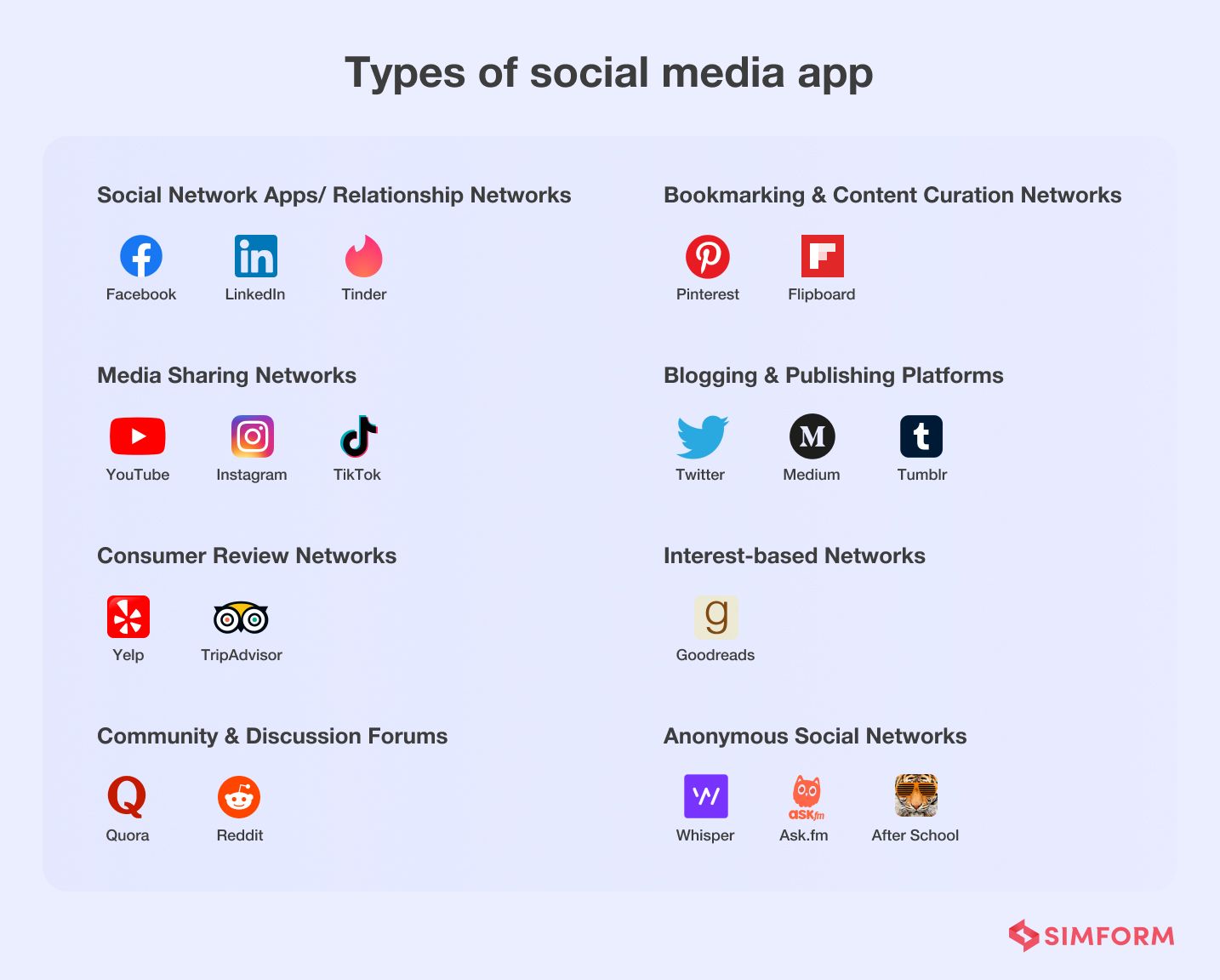
Competition research
Furthermore, competition research will help identify the strengths of competitors’ apps and what they lack, so you can identify the potential and opportunities for your product. It helps decide what features you must or must not include in your app to make it stand out in the market.
Step 2: Plan out the features
All the above research and analysis will help you plan the features, functionalities, and other technical aspects of your app. In this phase, you will also define a profitable monetization model of your social media app.
Monetization models for social media apps
You can either opt for a freemium model like LinkedIn or an advertising model used by apps like Facebook, Instagram, and YouTube. Moreover, you can also offer in-app purchases to your users for more revenue. For example, you can charge for specific podcasts, ebooks, courses, avatars, etc.
Depending on the app’s functionality and target audience, you can also mix up the strategies and get creative. Now let us look at the key features you should consider for your app as well as some advanced features.
Must-have features of a social media app
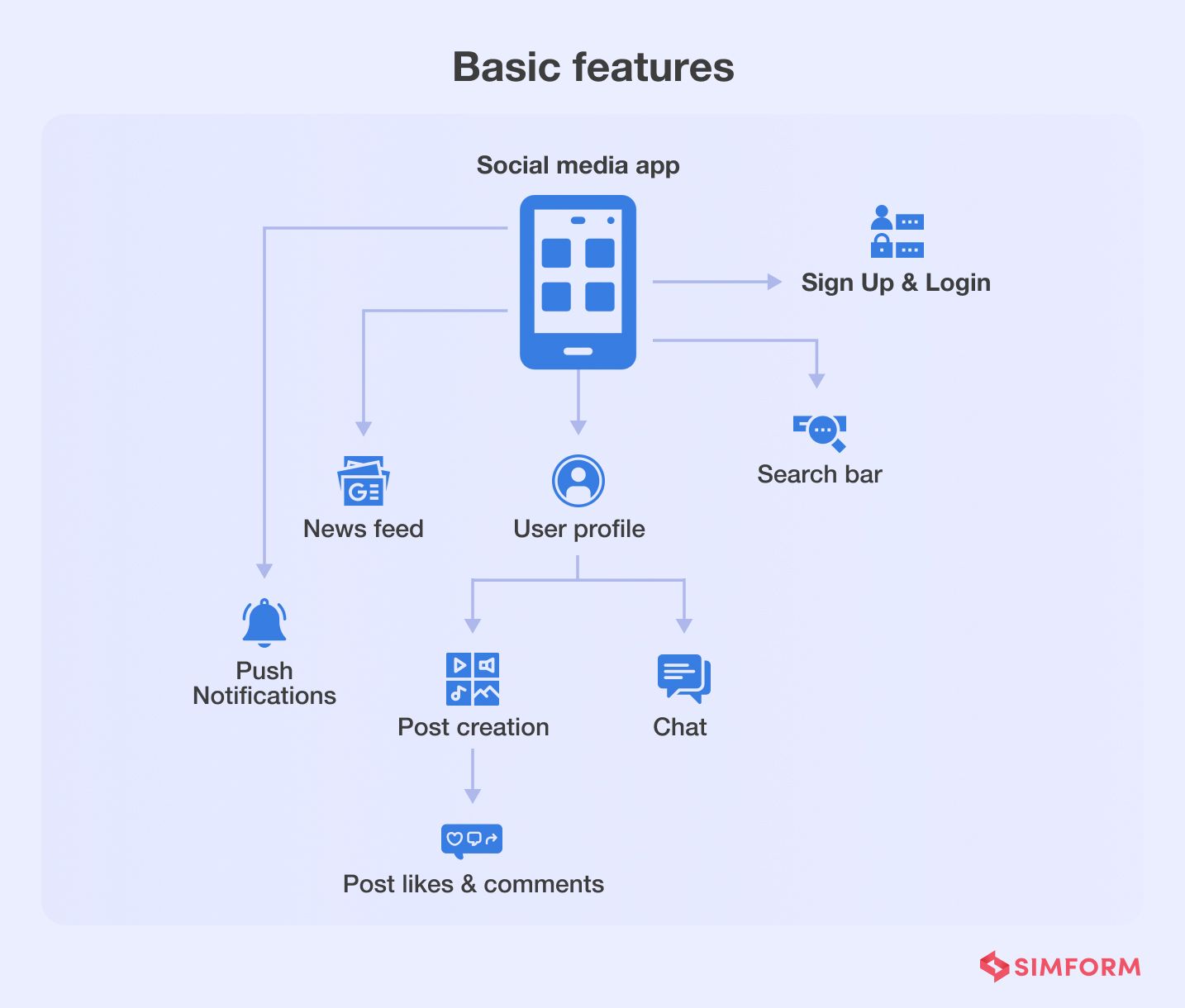
- Sign up & login
It is the most basic but irreplaceable feature which gives users access to your app. However, it should be easy and convenient for users to sign up or log in to the app. You can provide multiple ways such as phone registration, email, and password, and integrating with users’ existing accounts on Google, Facebook or Twitter.
- User profile
A user profile is a primary requirement for every social media app. It helps users add their name, location, photo, short bio, etc. It is preferable to make this feature customizable and multi-dimensional for users’ delight.
- Post creation:
An essential function of social media apps is to encourage users to create content and publish it. Therefore, users should be able to upload all content formats like text, images, videos, stickers, and more, depending on the type of app. In addition, you can add functionalities such as filters for images, audio/sounds for videos, or enabling users to highlight a chunk of their text post to make it more dynamic.
- Post likes and comments:
Social network apps thrive on user engagement. Therefore, the interaction between users and published content via likes, reposts, reactions, or comments is a must in a social media app. You can also integrate an option to share or cross-post to other social media apps for increased engagement.
- Newsfeed:
Newsfeed is the central space in the app where users can see updates from their connections, friends, and groups they follow. This feature needs to be implemented with complex algorithms to customize the feed as per each user’s individual preferences. For instance, you can use AI and machine learning algorithms to tailor the feed. Additionally, in-app notifications can also give detailed information on the activities of other users.
- Search bar:
A search bar enables users to navigate the app easily and find people, pages, groups, or other information in the app quickly. By offering advanced search, users can find more relevant content with the help of hashtags, keyword search, or special filters.
- Chat:
It is vital to provide in-app messaging to users for private communication, whether social or professional networking. An advanced version of this feature can also include group chats, voice notes, audio/video calls, chat pop-ups, etc.
- Push notifications:
Push notifications are critical drivers of user engagement that instantly notify users of activities in the app without logging in to the app. It is also necessary to implement this feature with a settings panel so users can mute, disable or receive notifications and set alerts according to their preferences.
Advanced features of a social media app
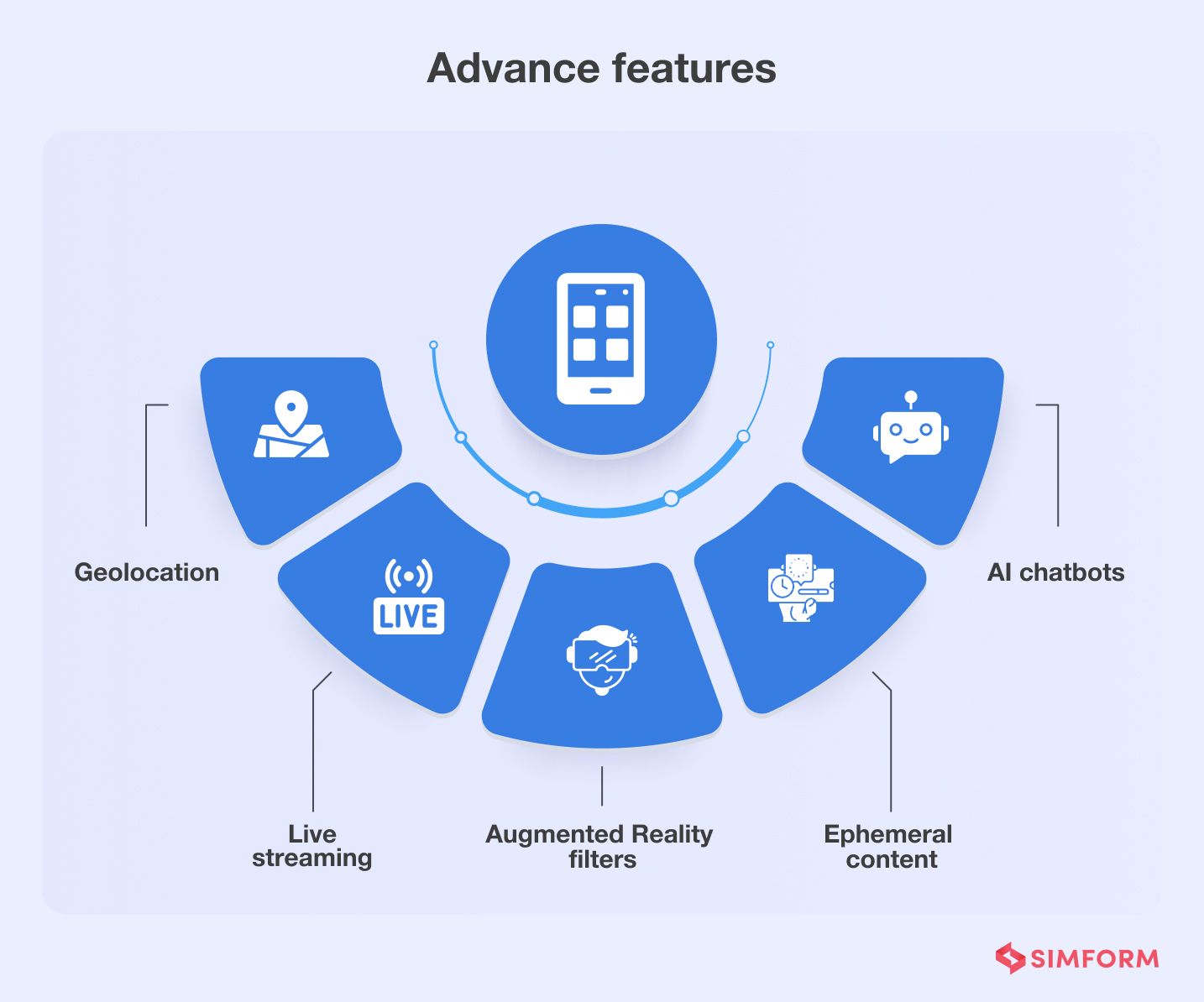
- Geolocation:
The geolocation feature allows users to mark locations on pictures, find other users nearby, update one’s location, and more. It also helps businesses see users nearby and promote brands or ads per users’ interests. For instance, geolocation is a must-have feature in dating apps.
- Live streaming:
Live video streaming has become extremely popular with Gen-Z as it allows users to communicate in real-time with their followers and share experiences. It is also a great way to do live Q&A sessions, interviews, product or fitness demos, and instantly connect with the audience.
- Augmented Reality filters:
Apps like Instagram and Snapchat have set the trend for AR filters for images and even videos. It is another feature popular with the younger generations and Gen-Z. Such filters instantly add a fun twist to the users’ posts, enable users to change avatars, and create a gamification effect making visual content more enjoyable.
- Ephemeral content:
Snapchat and Instagram have again set the trend for ephemeral content. It disappears after 24 hours, for example, stories and chat messages. The phenomenon of short-term content has increased the time users spend on social apps daily. Moreover, it has become trendy among influential groups of Gen-Z and millennials as they prefer authenticity over polished brand ads.
- Artificial Intelligence chatbots
Automated AI chatbots are also trending as they predict and respond to frequently asked questions, facilitate user interactions easily and save time. Adding this feature to your application toolkit can also help analyze user behavior and improve targeted audience marketing to boost business growth.
Step 3: Design & development
After having a mind map and functional specifications of your social media app, it is time to start the development process. It entails UI/UX design, front-end, and back-end development. Below we will discuss all these aspects in detail.
Design best practices
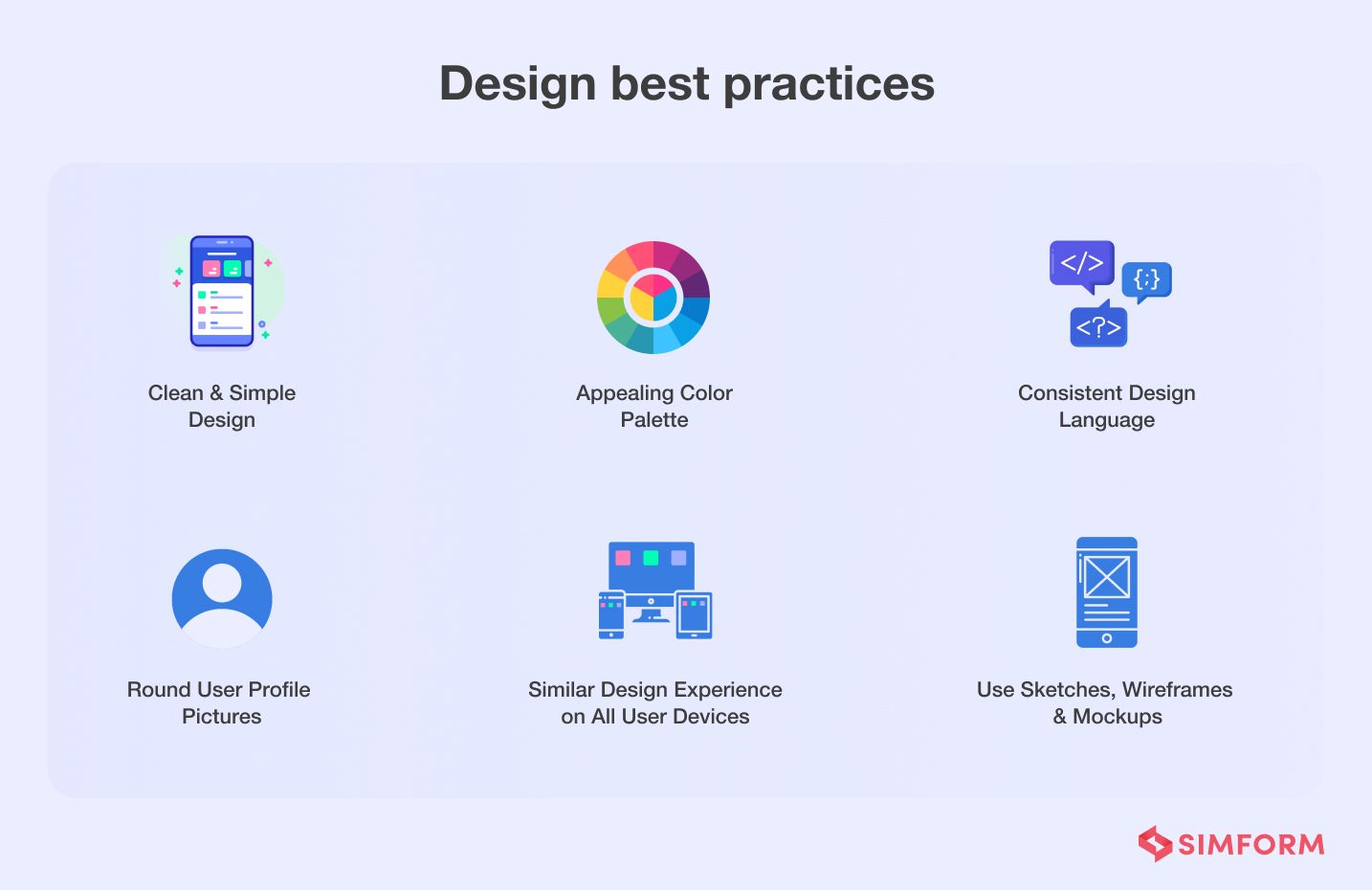
UI and UX of an app are the first aspects that the users see. Therefore, the app’s design must be attractive, intuitive, and user-friendly. Here are a few best practices our designers keep in mind while designing the UI/UX of a social media app:
- A clean, simple design that users can quickly familiarize themselves with is preferable. For instance, have a minimal number of steps to find and use a feature.
- A good choice of color palette is also crucial to a successful design. Include colors that appeal to users as well as emphasize your brand to increase its recognition.
- A consistent design language throughout the app creates a unified concept for all the visual elements in the app.
- Using round profile pictures focuses on the users’ faces and makes it easier to distinguish from a list of users.
- The app’s design should also be consistent on all the platforms to ensure a similar user experience when a user changes the mobile device or switches to your social media website.
- Lastly, using design tools like sketches, wireframes and mockups will help the entire team visualize how the app works, making the design process seamless.
The UI/UX design process and front-end development usually run together in the SDLC of a social media app. So next, we will examine the technology stack and frameworks for iOS and Android. The choice of technologies used will directly affect the performance and security of your future application.
Technology stack for a social media app
A social media app architecture has a three-tier structure consisting of a mobile client, backend, and database. Below is what an approximate tech stack of a social media app would look like:
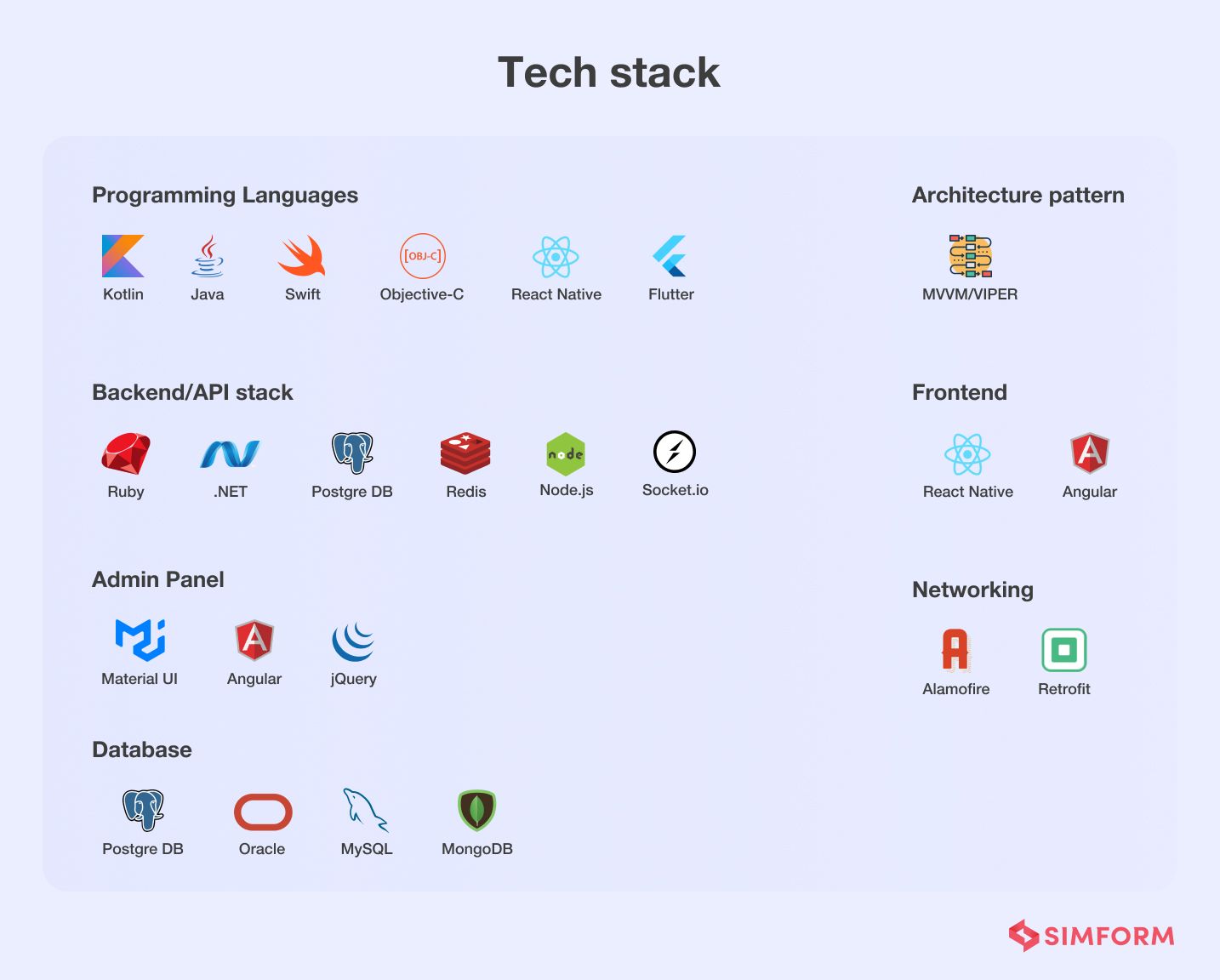
You will also need to decide the platforms you want to target: iOS, Android, or cross-platform development. Both Android and Apple use different technology stacks that we’ll discuss in the next section.
Frontend development
Frontend development is equally essential to a social media app as users spend most of the time interacting with the user interface. Angular and React are excellent options for building a mobile frontend of social media apps. These frameworks are used widely and can also be effectively used for the microservices approach or component-based approach to frontend development.
The client-side of a social media app is essentially defined by its key features like user profiles, feed, connections, and other such features as they keep the users engaged. Below we examine the technical implementation of these core social media mobile app features.
| Feature | Implementation on iOS | Implementation on Android |
| Social authorization | Facebook SDK, Twitter SDK, Google+ SDK | Facebook SDK, Google Play services authentication, TwitterCore |
| User profile | -UIImageView is used for the avatar, UIButton is used to interact with the user’s profile (subscribe/unsubscribe) & UITableView is used to see all the user’s information -Network layer: Codable, Alamofire/NSURLSession |
-RecyclerView is used for displaying user’s info (ImageView to display profile pictures & TextView to display user’s information in text format) -Network layer: Kotlin Flow, Kotlin Coroutines, Retrofit 2 |
| Newsfeed | UITableView, RxSwift, RxCocoa, RxDataSources, Alamofire/NSURLSession | RecyclerView, Kotlin Coroutines, Kotlin Flow, Retrofit 2 |
| Post creation | Alamofire/NSURLSession, Codable + self-written solution | Kotlin Flow, Kotlin Coroutines, Retrofit 2 + self-written solution |
| Post likes | -UI layer: UILabel & UITableView is used to display the likers list -Network layer: Alamofire/NSURLSession, Codable |
-UI layer: TextView & RecyclerView is used to display the likers list -Network layer: Kotlin Flow, Kotlin Coroutines, Retrofit 2 |
| Search | -UI layer: UITableView, UISearchBar -Network layer: Alamofire/NSURLSession, Codable |
-UI layer: SearchView, RecyclerView -Network layer: Retrofit 2, Kotlin Flow, Kotlin Coroutines |
| Chat | -UI layer: UITableView -Network layer: Alamofire to perform networking tasks, SocketRocket real-time communication with the server (CoreData/Real framework is also used for offline & online chat data storage.) |
-UI layer: RecyclerView -Network layer: Retrofit 2 is used for network requests & WebSocket is used for instant (real-time) messaging |
| Push notifications | Push Notification Service/Firebase Cloud Messaging | Firebase Cloud Messaging |
| Geolocation | MapKit/ Google Maps | Google Maps, Location API |
Backend development
As for backend development or server-side programming, the choice of technology needs to be more robust. Backend determines the performance, scalability, and efficiency of your social media app. It also includes setting up databases, servers, storage solutions, APIs, etc. It must be based on the requirement of your app, like the number of users it will have or the amount of load the backend will be expected to handle.
The entire infrastructure of your app, including frontend, backend, and databases, can also be hosted on the cloud. It allows you to upscale when needed to help save costs and eliminate idle resources when there is less traffic.
The key backend features of a social media app include an admin panel and database. Let’s discuss them in detail.
- Database
Social media apps require enormous amounts of data to be included, processed, and put away. Hence, they need a database tier. There are multiple choices for SQL and NoSQL databases available. Based on the app’s requirements, you can choose from options like MySQL, PostgreSQL, MongoDB, and more.
If your app’s users increase in the future, the amount of data will increase too. Thus, your database must be scalable, flexible, and equipped to handle multiple queries at a time. Moreover, speed is critical for social media apps. So the database must be robust and secure too.
- Admin panel
Social media apps require an admin panel to monitor and access all the data sourced from the app. It provides information like the number of active users, the content they share, posts they interact with, and other users’ activities. Admin panel is a must for apps with user-generated content. It allows you to manage users and the content. For example, you can remove abusive or threatening content, block or delete a user account, etc.
Integrating third-party analytics tools in the admin panel also allows you to study users’ behavior. It provides valuable insights on what users want so you can add features and improve your app accordingly.
Development best practices for a social media app
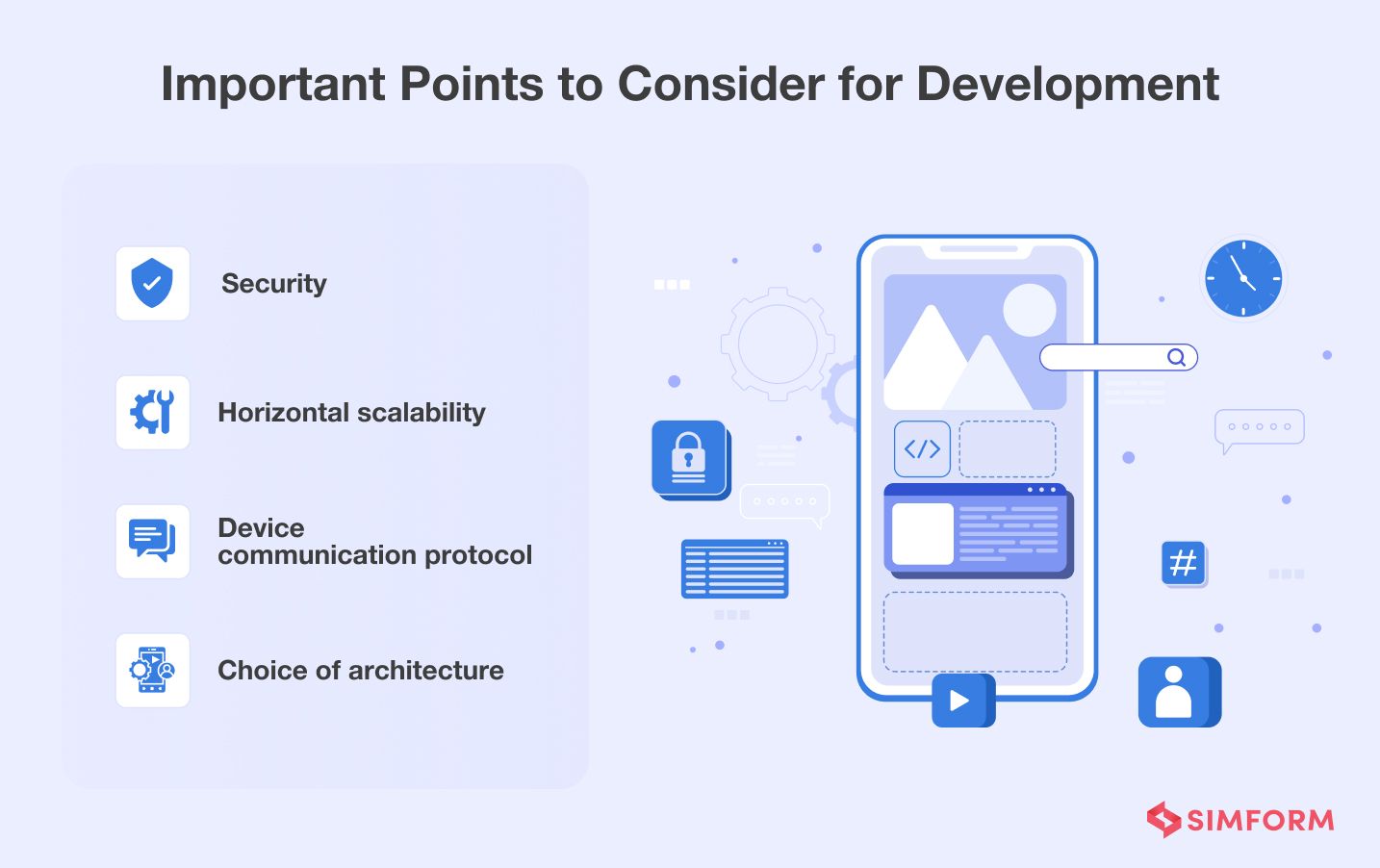
1. Security:
Users’ data security and privacy are of utmost importance in social media apps. Security vulnerabilities and inefficient permission-based mechanisms in Android have paved the way for different security hazards. Android developers can implement additional security measures such as:
- complex data encryption,
- high-level cryptography tools/technologies,
- integration with authorized APIs,
- Android Keystore system.
As for iOS apps, weak cryptography, jailbreaking, or insecure data storage are possible hazards that can compromise iOS’s strong security. iOS developers can apply the following additional measures:
- Use authorized APIs,
- Avoid storing cryptographic keys in the code or locally,
- Use long-lasting cryptographic standards and algorithms like ATS
2. Horizontal scalability:
To handle user growth and expanding data, your architecture must be horizontally scalable. Different types of load balancers can help provide proper functioning with the following solutions:
- Hardware load balancing
- Software load balancing
- Mixed load balancing
- DNS load balancing
Check out this case study on how we built a scalable tech architecture for the ONA Dating app.
3. Device communication protocol:
The choice of technology also affects the communication and the immediate response of the mobile app to the server-side. Therefore, REST API is a must for social media apps as it obtains all the necessary data from the server. Developers can also consider WebSocket, which enables open connection between the client-side and web server or the long-polling technology.
4. Choice of architecture:
The efficiency of your social media application directly depends on the back-end architecture. So you need to choose the model of development during initial planning carefully. For instance, opting for microservices architecture allows writing a project in different programming languages simultaneously, thus, providing flexibility and scalability. And in case you want to host your services in the cloud, ready-made microservices management systems will ease the development process, such as AWS Lambda.
Step 4: Testing and Quality Assurance
Testing and Quality Assurance are essential elements of a successful app development process. And these steps need not be carried out only after the development. On the contrary, it is best to integrate testing and QA from the beginning of the project and carry it out simultaneously throughout the SDLC.
Testing and quality assurance finds bugs, fix them, and help eliminate crashes to ensure the result complies with the product requirements. Testers and QA engineers perform various functional and non-functional testing types, including unit testing, integration testing, device testing, end-user testing, etc. The tests are performed either manually or in automation, based on the project size, complexity, and other requirements.
For instance, load testing is significant for social media applications. It helps verify if the app performs equally well with one active user or a million active users.
Step 5: Post launch
Now your social network app is ready to be launched on the app stores. And once it is deployed to the market, your app will require regular updates and bug fixing, if any. However, you can track the growth of your app with quantitative metrics and KPIs from the app. It helps identify gaps, weaknesses and generate data-driven insights to improve your app to better fit the users’ needs. Below are some essential user engagement and revenue-focused KPIs that will help you analyze and boost business growth.
Quantitative metrics for social media apps
- Acquisition: CPI & CAC
Customer Acquisition Cost (CAC) is the overall cost incurred to acquire a new user, including the cost of marketing ads, campaigns, and other promotional activities. It helps determine if the app’s revenue model is viable and improves RoI.
Cost Per Install (CPI) is the cost of advertising divided by the number of app installs. It helps analyze the viability of your paid advertisements.
- User activation rate
User activation rate shows the number of active users in comparison to app downloads. Various actions of a user can be a sign of activation, such as uploading the first post, sending the first message, or interacting with a key feature for the first time.
- User retention and Churn rate
User retention rate is calculated as the number of users who returned to the app based on their first visit date. And churn rate is the number of users that stop using your social media app.
Both the metrics help check if the user growth has improved after a new update in the app and find out what is working for your app.
- User engagement
User engagement is the number of actions a user takes in the app. It is also measured by session length or interval, which shows how long a user spends time on your app. The higher the rate, the better.
- Traction
Traction is quantitative evidence of your app’s market demand which shows patterns and month-on-month growth of your app users.
- Burn rate
Burn rate shows the amount of money you spend on your app monthly, including server costs, app maintenance, staff, marketing and sales cost, etc. It helps social media startups plan and track monthly expenditures, future fundraising, and revenue growth.
Now that we know all the aspects of developing a social media app, it’s time to look at the financial side. Let us find out how much it costs to develop a social media application.
How much does it cost to create a social media app?
A myriad of factors affects the cost of a social media app, such as the number of features you want to include, their complexity, the development team, their location, etc. It also includes expenses of marketing, maintenance, regular updates, and other costs. Below we will discuss the key factors that will help determine a rough estimate for social networking app development. And we will also understand the cost breakdown based on stages of mobile app development for a better estimate.
Development cost
The number of features, functionalities, and their complexity directly influence the development hours and, thus, the app cost. Moreover, the integrated APIs or the complexity of the backend will also require more financial resources.
The below tables show the approximate development cost (based on an agency’s $25/hr average rate) for the basic features of a social media app, advanced features, and other backend features.
| Feature | iOS/Android Development Cost (in USD) | Cross-platform Development Cost (in USD) |
| Basic features | 18,625-33,375 | 21,950-28,200 |
| Advanced features | 9,000-10,250 | 9,000-10,250 |
| Admin Panel (one for all platforms) | 7,500-8,250 | 7,500-8,250 |
| Frameworks and libraries integration | 3,750-5,500 | 3,750-5,500 |
| Total Development Cost | 38,875- 57,375 | 42,200-52,200 |
Cost Breakdown Based on Stages of Social Media App Development
A complete app development process starts with business research and ends with launching, maintenance, and upgrading the app. Each stage requires a chunk of the total app development budget. To estimate the overall cost of your social media app, let’s look at the time and cost required stage-wise. The below estimates are for a basic social media app with a few advanced features and are calculated based on an agency’s $25/hr average rate.
| Stage | Time taken (in hours) | Cost (in USD) |
| Business Analysis | – | 1,500-5,000 |
| UI/UX Design | 200+ | 5,000-10,000 |
| Development | 1,555-2,295 | 38,875- 57,375 |
| Quality Assurance | 140-300 | 3,500-7,500 |
| Project Management | 200-240 | 5,000-6,000 |
| Total Cost | – | 53,875-85,875 |
Note: The above figures are ballpark estimates, and the actual cost may vary depending on the project needs. For accurate estimations, you can get in touch with us and set up a free consultation.
Target platforms and devices
Social media app development cost is also directly affected by the number of platforms and devices you want to target. Based on essential aspects such as your target audience, market fragmentation, localization, etc., you can choose between iOS and Android for a mobile app. You can also consider a web app version for compatibility with other operating systems and devices.
But more the number of platforms, more the cost. You can initially launch for one platform and then port to another. For example, Instagram initially launched only for iOS in 2010. It rapidly gained popularity, and the Android version was released later in April 2012.
If your target audience is equally divided between iOS and Android, you can consider cross-platform application development. Cross-platform apps are designed to run on both Android and iOS with a single codebase and will cost less than developing separate native apps for iOS and Android.
Development partner and engagement model
The cost to develop a social media app also largely depends on the hourly rates of the developers involved. But building social media apps requires experience and the right skill sets. And the development process also requires designers, testers, and project managers. While hiring a team to build your social media app, you can take three major routes, which are as follows:
- Hire freelancers
Freelance app developers charge lower hourly rates than app development companies or agencies. But you will need to hire different freelancers for designing, coding, and testing while managing the team yourself. And the hourly rates will also differ as per their location. For example, freelance developer rates in India start from $10 per hour, whereas hourly rates of developers from the USA start from $50 per hour.
- Hire app development agency aka Outsourcing
Outsourcing your social media app project is more advantageous in terms of reliability, security, and getting timely, quality-assured results. The teams of app development agencies will guide you through all the phases from planning to deployment. The teams are highly qualified, experienced and consist of the following professionals:
- Business Analyst
- UI/UX Designers
- iOS/Android Developers
- Quality Assurance Engineer
- Project Manager
The size of the team will directly depend on the complexity of the project, its size, and the engagement model you choose. The hourly rates charged by app development companies are comparatively higher and depend on the company’s location. For example, US-based companies charge $100-$250/hour, whereas Indian companies with the same quality and expertise charge $25-$40/hour.
- Hire dedicated remote developers/extended team
Hiring dedicated professionals from a software development company like Simform is another excellent option. You can hire dedicated remote developers, project managers, and other required professionals without any legwork of vetting candidates, payroll, etc. In addition, dedicated developers will only work on your project, as opposed to freelancers, which does not hamper the quality of work. It is also preferable when you already have an in-house team but want to add development capacity or extend your team on demand.
To sum up, a social media app can cost anywhere between $45,000- $80,000. More complex apps with advanced features and design can even cost above $200,000. Additionally, apps require regular maintenance and updates that add to the cost. You will also need to include other costs such as app store charges, database, server costs, app patenting, and marketing costs.
Create a stunning social media app with Simform
The social media app market is booming, but your app can still thrive if it has unique features and a unique idea behind it. And now that you know how to make a social media app from scratch, you can turn your genius app idea into a successful digital product. Our team of experts can also help make your concept into a stunning app with their brilliant ideas and experience. However, if you want to explore more possibilities and get an accurate cost estimate, please feel free to contact us!